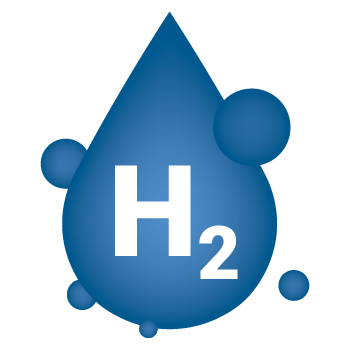SUPERMOLECULAR TREATMENT WITHOUT CHEMISTRY
Production and treatment of Hydrogen
In the production of hydrogen, we currently encounter problems such as: energy-intensive production, transportation, storage, quality, and others. The goal of technology is to help solve these problems.

Clean energy is the future
Hydrogen accounts for less than 2% of current energy consumption in Europe and is primarily used in the production of chemical products such as plastics and fertilizers. Of this hydrogen production, 96% is produced using natural gas, which emits a significant amount of CO2 in the process. However, hydrogen can also be produced from renewable sources. Renewable hydrogen (“green” or “clean” hydrogen) is expected to play a key role in the decarbonisation sectors, such as transport and energy intensive industries, where other alternatives will not be possible or will be more expensive. Currently, hydrogen is an important element in technically complex welding and manufacturing processes. Its use is also in energy industry and is slowly coming to the fore in transport, where it is planned as a substitute for fossil fuels.
Current problems with hydrogen

Clean energy is the future
Hydrogen accounts for less than 2% of current energy consumption in Europe and is primarily used in the production of chemical products such as plastics and fertilizers. Of this hydrogen production, 96% is produced using natural gas, which emits a significant amount of CO2 in the process. However, hydrogen can also be produced from renewable sources. Renewable hydrogen (“green” or “clean” hydrogen) is expected to play a key role in the decarbonisation sectors, such as transport and energy intensive industries, where other alternatives will not be possible or will be more expensive. Currently, hydrogen is an important element in technically complex welding and manufacturing processes. Its use is also in energy industry and is slowly coming to the fore in transport, where it is planned as a substitute for fossil fuels.
Current problems with hydrogen
Hydrogen propulsion Treasure ©
Improved hydrogen cleavage
The production process takes place directly in the engine part of the vehicle using an electrolyser that is powered by its own source. The car does not need hydrogen storage tanks. It is a low-voltage Treasure © electrolysis with its own control. Hydrogen is produced from molecularly treated water, which ensures its more efficient cleavage into hydrogen and oxygen. The design solution is suitable for both diesel and petrol powered cars. The advantage is reduced fossil fuel consumption. The automotive industry will appreciate the adaptability of the device, as it is still in the process of improving the technological solution.

Hydrogen propulsion Treasure ©
Improved hydrogen cleavage

The production process takes place directly in the engine part of the vehicle using an electrolyser that is powered by its own source. The car does not need hydrogen storage tanks. It is a low-voltage Treasure © electrolysis with its own control. Hydrogen is produced from molecularly treated water, which ensures its more efficient cleavage into hydrogen and oxygen. The design solution is suitable for both diesel and petrol powered cars. The advantage is reduced fossil fuel consumption. The automotive industry will appreciate the adaptability of the device, as it is still in the process of improving the technological solution.

Hydrogen production in industry
Decarbonization



